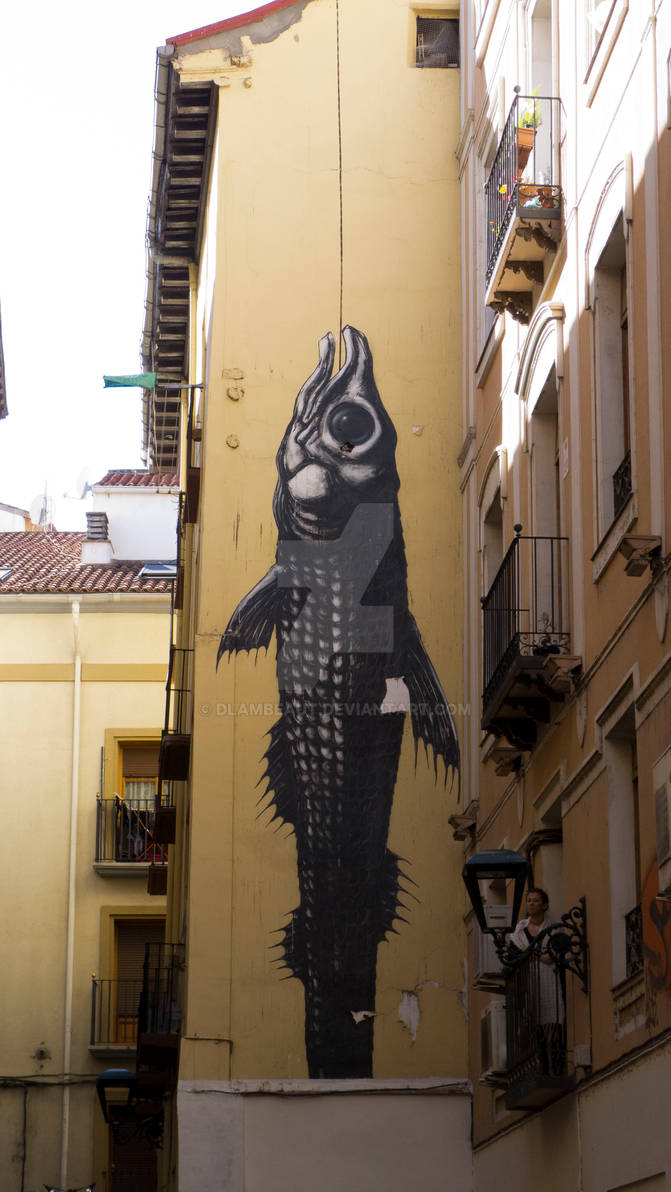Deviation Actions
A few days ago, taking advantage of some free time before lunch, I took a walk downtown, camera around my neck, with the idea of getting some stock photos, and maybe some "street photo" with which to start my journey in that discipline.
In my stroll in discovered this:
Actually I already knew this graffiti, I had passed by this point several times before, and I loved it, so my meeting was in part intentional, with the idea of planning a future picture of it.
Photo that I can no longer do because someone has “amputated” its tail.
If anyone is interested to know how was the whole fish with its tail, you can use these links:
upload.wikimedia.org/wikipedia…
walkingonthestreet.wordpress.c…1
I think at this point, only the most reactionary continue to deny that graffiti can be considered some kind of art. With good and bad artists, civic or subversive, timely or untimely, but art, after all. Names like Basquiat, Banksy, OBEY, or Pez in our country, begin to be familiar to most (as you see, I'm no expert on the subject, and I had to google some of the names).
I understand, on the other hand, the attitude of the authority or particular to the conservation of their walls, something that cost money, and therefore an effort, and do not liking that something that defaces property.
But I know that these two paradigms, basically divergent, sometimes cross their paths in corners or alleys like this one (street Don Pedro Atarés of Zaragoza, in case anyone would like to visit in person), easing a little artist angst without offending the brick and asphalt but giving a little life and color to them.
That's why I do not understand why they had to paint over the fish's tail. Why the contracting hasn’t had the delicacy to ask the contractor to not paint over it, or the contractor has had the wisdom to ask the contracting whether to or not to pardon her. Why have they abandoned common sense in the interest of some misunderstood civility.
A painting, I will not call it graffiti now, in these dimensions, regardless of their artistic quality (in this case irreproachable) requires a significant effort in planning and execution. It is art. Art on a wall that is not front on a street with little traffic, in a deteriorated urban area.
He did not deserve what they have done. It was not justified to paint over it.
Today we celebrate the end of Carnival, the end of subversion, excess, color and creativity, here called, coincidentally, el “Entierro de la Sardina”: The Burial of the Sardine. My sincerest condolences to artistic community in general, and to graffiti artists in particular.
Requiescat in pacem.
Versión en español: PANEGÍRICO A UN PEZ (SIN COLA)
Hace algunos días, aprovechando un rato libre antes de comer, me di un paseo por el centro, cámara al cuello, con la idea de conseguir algunas fotos de stock, y puede que alguna “street photo” con la que comenzar mi andadura en esa disciplina.
En mi deambular pude descubrir lo que se ve en la foto de arriba.
En realidad ya conocía este grafiti; ya había pasado por este punto varias veces antes, y me encantaba, así que mi encuentro era en parte intencionado, con la idea de planificar una futura foto del mismo.
Foto que ya no podré hacer, porque al pez le han “amputado” la cola.
Si alguien está interesado en saber cómo era el pez completo, con su cola, puede usar estos enlaces:
upload.wikimedia.org/wikipedia…
walkingonthestreet.wordpress.c…1
Creo que a estas alturas, sólo los más reaccionarios siguen negando que el grafiti pueda considerarse una forma de arte. Con buenos y malos artistas; cívico o subversivo; oportuno o inoportuno; pero arte, al fin y al cabo. Nombres como Basquiat, Bansky, OBEY, o Pez en nuestro país, empiezan a resultar familiares para la mayoría (como veis, no soy un experto en el tema, y he tenido que googlear alguno de los nombres).
Entiendo, por otro lado, la actitud de la autoridad o el particular, al que el acabado y conservación de las paredes cuesta un dinero, y por tanto un esfuerzo, y al que no le gusta que se pintarrajee algo que es de su propiedad, o de propiedad colectiva, y no el lienzo de una artista callejero al que considera, cuando menos, una molestia como lo puedan ser las humedades, los hongos o las goteras.
Pero sé que estos dos paradigmas, básicamente divergentes, a veces cruzan sus trayectorias en esquinas o callejones como éste (calle Don Pedro Atarés de Zaragoza, por si alguien quisiera visitarlo en persona), aliviando un poco la angustia vital del artista sin ofender al ladrillo y al asfalto a los que otorga un poco de vida y color.
Es por eso que no entiendo por qué han tenido que pintar sobre la cola del pez. Por qué ni el contratante ha tenido la delicadeza de pedirle al contratista que no pintara sobre ésta, ni el contratista ha tenido la prudencia de preguntarle al contratante si debía, o no, indultarla. Por qué han abandonado el sentido común, en aras de un mal entendido civismo.
Una pintura, no la llamaré ahora grafiti, de estas dimensiones, al margen de su calidad artística (en este caso irreprochable) requiere un importante esfuerzo de planificación y ejecución. Es arte. Arte en una pared que no es fachada, en una calle de poco tránsito, en un ámbito urbano deteriorado.
No se merecía lo que le han hecho. No estaba justificado pintarle encima.
Hoy celebramos el fin del Carnaval, el final de la subversión, el exceso, el color y la creatividad, que aquí llamamos, casualmente, el Entierro de la Sardina. Mis más sinceras condolencias a comunidad artística en general, y a los grafiteros en particular.
Requiescat in pacem.
